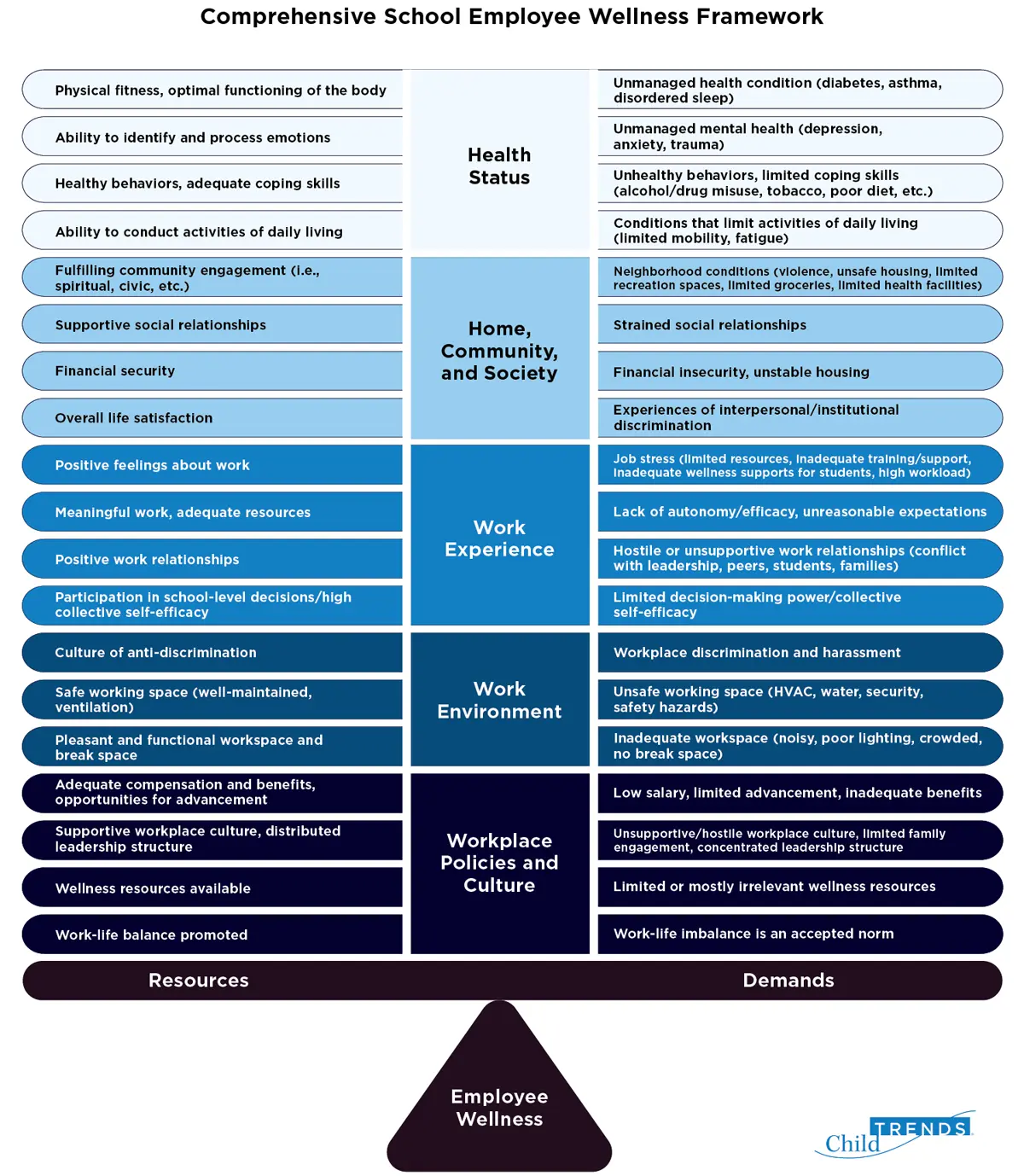A Comprehensive School Employee Wellness Approach Can Reduce Staff Stress and Attrition
Author
The COVID-19 pandemic has taken a significant toll on the well-being of school staff nationwide, with nearly one in four teachers indicating that they would likely leave the profession after the 2020-2021 school year. While many schools offer wellness initiatives—like providing healthy food options in staff vending machines and hosting mindfulness trainings—a shift to a comprehensive, coordinated approach to employee wellness is essential.
Failure to adequately address employee wellness may exacerbate pre-existing staffing shortages and further disrupt schools recovering from the pandemic. To help education leaders implement more effective employee wellness initiatives and better leverage federal pandemic relief funds, leaders should align their efforts with Child Trends’ proposed Comprehensive School Employee Wellness Framework, which uses five core components of wellness to address three critical gaps in school systems’ current approach.

The first gap is the narrow scope of most school employee wellness programs, which have traditionally focused on physical health. More recently, school systems have expanded their focus to include employee mental health, adding meditation, mindfulness, and yoga classes as core strategies. However, research suggests that wellness depends heavily on individual, interpersonal, organizational, community, and societal contexts —including social determinants of health such as experiences of racism and trauma. Employee wellness efforts should seek to integrate efforts that target multiple levels of influence.
Child Trends’ Comprehensive School Employee Wellness Framework
Our evidence-informed framework draws from two definitions of employee wellness. Our five core components of wellness—Health status; Home, community, and society; Work experience; Work environment; and Workplace policies and culture—are borrowed from the National Institute for Occupational Safety and Health (NIOSH). Within each component, we present indicators informed by the Job Demands-Resources Model, which highlights the need to consider both resources and demands that influence wellness.
This framework is still under development, and we welcome feedback as we refine it. Click here to send us feedback.
The second gap is the lack of coordination of school employee wellness efforts, particularly the limited integration of efforts addressing health status with efforts to address workplace conditions. Several states and school systems promote positive workplaces through their teacher recruitment and retention programs (e.g., loan reimbursement, mentoring, and protected planning time), as well as through facilities construction and maintenance. However, such efforts may fail to support employee wellness if they are not coordinated. For example, mindfulness training or yoga classes are likely to be more effective in a school system that also provides staff with adequate planning time than in a system where planning time is scarce; the latter makes it difficult for staff to engage in wellness activities given the amount of time required for preparing lessons, grading assignments, attending meetings, and other administrative tasks. The Centers for Disease Control and Prevention has outlined a data-driven process for coordinating employee wellness efforts.
The third gap is the current over-reliance among education stakeholders on promoting positive coping strategies without pairing such efforts with strategies to limit exposure to conditions that lead to unwellness. Our framework balances resources (i.e., factors that can promote wellness, such as healthy habits, safe workspaces, and supportive work policies) with demands (or factors that can diminish wellness, like unmanaged health conditions or hostile workplace culture). An approach that increases resources and reduces demands will be most likely to achieve a sustainable wellness balance.
The influx of federal dollars through the American Rescue Plan and other pandemic relief funds represents the best opportunity in decades for state leaders to support local education agencies and schools in investing in a comprehensive and coordinated set of employee wellness policies and practices. While the federal relief funds may be time-limited, state leaders can encourage local leaders to prioritize sustainable strategies that enhance employee wellness, increase staff retention, and improve student learning.
This product is supported by cooperative agreement NU87PS004367-01-01 funded by the Centers for Disease Control and Prevention (CDC). Its contents are solely the responsibility of the authors and do not necessarily represent the official views or endorsement of the CDC or the Department of Health and Human Services.
© Copyright 2024 ChildTrendsPrivacy Statement
Newsletter SignupLinkedInThreadsYouTube